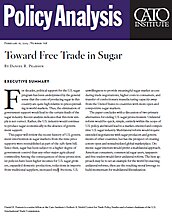For decades, political support for the U.S. sugar program has been underpinned by the general sense that the costs of producing sugar in this country are quite high relative to prices prevailing in world markets. Thus, the elimination of government support would lead to the certain death of the sugar industry. Recent analysis indicates that this view simply is not correct. Rather, the U.S. industry would continue to produce sugar economically in the absence of government support.
This paper will review the recent history of U.S. government intervention in sugar markets from the time price supports were reestablished as part of the 1981 farm bill. Since then, sugar has been subject to a higher degree of government control than any other major agricultural commodity. Among the consequences of those protectionist policies have been higher incomes for U.S. sugar growers, expanded domestic production, reductions in imports from traditional suppliers, increased trade frictions, U.S. unwillingness to provide meaningful sugar market access during trade negotiations, higher costs to consumers, and transfer of confectionary manufacturing capacity away from the United States to countries with more open and competitive sugar markets.
The paper concludes with a discussion of two primary alternatives for ending U.S. sugar protectionism. Unilateral reform would be quick, simple, entirely within the scope of U.S. policy, and would lead to a market-oriented and competitive U.S. sugar industry. Multilateral reform would require extended negotiations with sugar producers and governments of other countries, but has the prospect of creating a more open and nonsubsidized global marketplace. Domestic sugar interests would prefer a multilateral approach. American consumers, commercial sugar users, taxpayers and free traders would favor unilateral reform. The best approach may be to set an example for the world by enacting unilateral reforms, then use the resulting moral leverage to build momentum for multilateral liberalization.

This work is licensed under a Creative Commons Attribution-NonCommercial-ShareAlike 4.0 International License.

